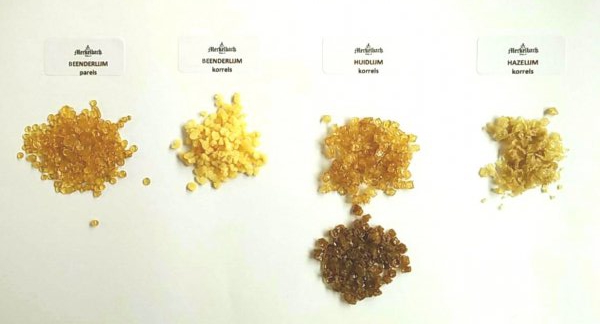With an adhesive you can attach things to each other. It has been used for thousands of years. But how do you make it without synthetic resins and plastics?
Animal glue
 (gelatine, isinglass, skin glue) is an animal gelatin.
(gelatine, isinglass, skin glue) is an animal gelatin.
It normally contains 8-12% moisture, practically does not dissolve in cold water, but it can swell in it. Upon heating the water, the proteins shall be in colloidal solution. If the dissolved amount is large enough (10% or more) than it solidifies upon cooling as a whole up to a gelatinous mass (gel). Bone glue stinks, hide glue (almost) not.
Gelatin is a protein obtained by partial hydrolysis (degradation, cleavage under absorption of water) of collagen, a protein extracted from connective tissue (of mammals). This is in offal: skins, bones, cartilage, tendons, etc.
Gelatin is hardly soluble in cold water but well in warm water. Then take the gelatin molecules about 1-10 times their weight in water. When heated above 40 degrees gelatin dissolves completely.
Upon cooling, a rigid gel is formed. The solubility is dependent on temperature, concentration and particle size. Gelatin is insoluble in alcohol and other solvents.
It is for use in candies, food (dessert), hard and soft capsules for medicines and cosmetics, bath beads, glue.
Gelatin is created by skin, bones, hooves (even meat)... to pull long in hot water, such as broth. So solve the soluble constituents. Then the result is thickened.
In order to make the gelatine or animal glue water-resistant, inter alia, formaldehyde, aluminum sulfate, or alum may be added.
Isinglass is a substance drawn from the dried swim bladders, skins and scales of fish. It is a form of collagen (gelatin basis), now mainly used to make wine and beer brighter.
Isinglass was originally made exclusively from swim bladders of sturgeon (species), later cod and others (eels gives oily glue.)
Bone glue (also called hot glue or cooking glue) is usually made from beef bones.
The addition of 5% acetic acid makes the ossein stronger.
The addition of 5-10% of urea or thiourea makes that the adhesive is slower to gel.
By adding more he will not gel anymore and can be processed even cold. But the shelf life is shorter.
The ancient Egyptians 3,000 years ago were sticking their wooden pieces already with bone glue.
Those 3,000 year old links are still deadlocked.
"Russian glue“ is just bone glue to which lead white was added to prevent spoilage.
A good bone glue connects with a force of more than 70 kilograms per square centimeter.
A too low humidity makes bone glue brittle, 10 to 15% is optimal. In too high humidity it softens.
By heating ossein briefly at 95 degrees and immediately cool quickly are micro-organisms turned off and the shelf life enhanced.
Skin glue is stronger, more flexible and tougher than bone glue. Especially those of rabbit and hare skins were known and popular.
Wash skin. Soak them in water with lime and / or ash in order to remove the hair. Thoroughly clean and rinse. Cut into pieces, boil gently (not too hot, otherwise adhesive proteins degraded), gelling into jars and allow to dry.
Can be made more flexible with honey or sugar.
The “Bloom number' is the most important quality characteristic for gelatin and animal glue. It expresses the gel strength. This is measured by dissolving a concentrate in water and to cool down to gel and then to press. The number of grams that is necessary in order to reach a certain depth, is the Bloom Number. Bloom Number < 150 = low, 150-220 = medium, > 220. = High Bloom Number.
Adhesive with a low Bloom Number has less water, the adhesive film is flexible and shrinks less.
In contrast, the glue has to dry longer, about 2 or 3 days.
An adhesive with high Bloom Number dries faster, but also gives a greater shrinkage because you also need to add more water to dissolve. It is stronger, tougher and more elastic, has a high viscosity and elasticity, and long polymer chains.
Title Bloom Number (at a concentration of 12.5%)
Bone glue 100-150 g (relatively brittle)
Skin glue 100-500 gr. (flexible)
Hare glue 300-450 gr.
Sturgeon glue no dates, hard to find
Isinglass no data, but based on gel point < 100 gr.
Gelatin 150-900 gr
Curd and protein are also useful as an adhesive.
Casein is the in sour milk clumping protein.
Casein has long been used as an adhesive substance (curd glue), where lime was added. Around 1912 they started in Switzerland with the industrial production of casein glue. It is a method designed to dry the chees glue and process into powder. Addition of water then gave a cold glue.
Dissolved in water and lime it gives a non- water-soluble, so a waterproof glue!
